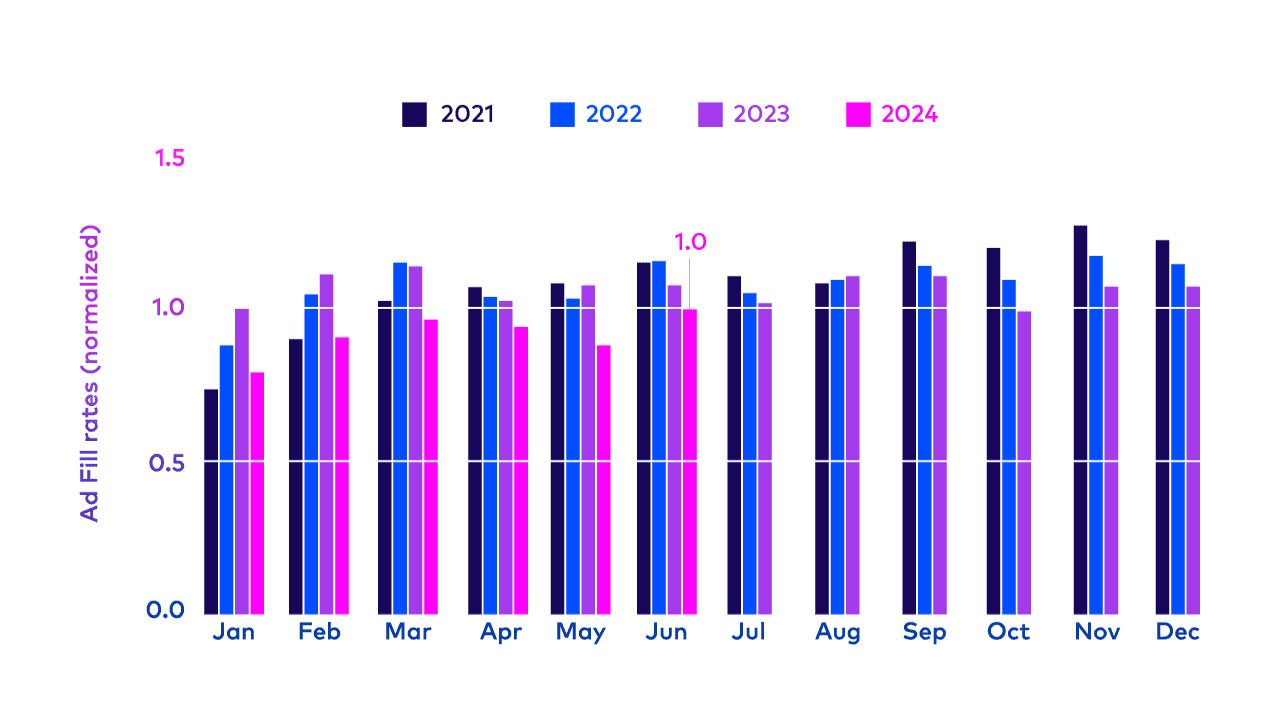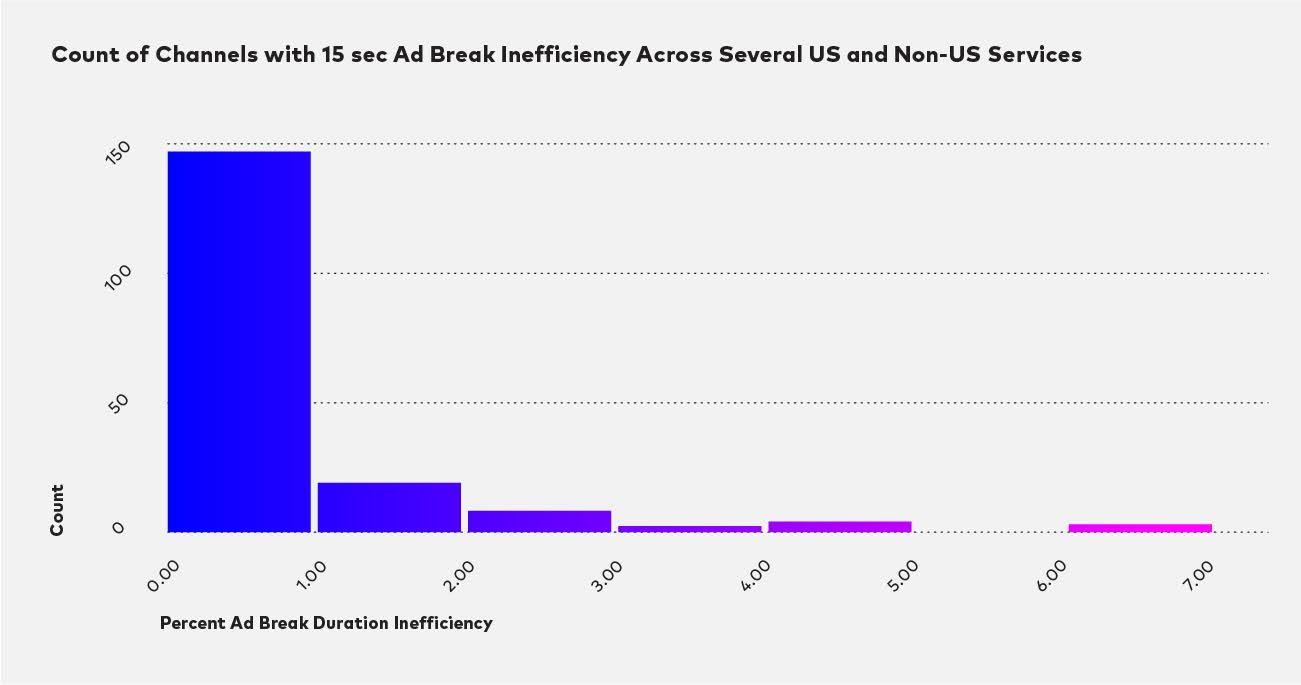Ad Fill Rates: Strategic insights and trends for publishers in 2024

Ad Fill Rate indicates the proportion of available ad inventory that is successfully filled with advertisements. High Ad Fill Rates are paramount for publishers looking to maximize revenue and streamline operations. This article delves into the nuances of Ad Fill Rates, exploring their cyclical patterns, seasonal variations, and offers strategic insights for improvement.
Ad Fill Rate trends in 2024
As outlined in Wurl’s CTV Trends Report 2024, there have been some interesting recent developments in Ad Fill Rates.
As ad-supported content has increased — a success that is evidenced by the heavy hitters of Amazon and Netflix now offering ad-supported subscription tiers — that means there is significantly more ad inventory on the market. But despite larger investments in streaming ad campaigns, advertiser demand has not kept pace with the increased supply. This has led to a decline in Ad Fill Rates year over year and across each quarter in 2024.
The Ad Fill Rate chart reveals several key patterns:

Fill rates were roughly 18% lower in Q1 2024 compared to Q1 2023: this is most likely due to an explosion of supply in the market.
But beyond this wider trend, what are the key takeaways for publishers who are trying to mitigate lower Ad Fill Rates?
Fill Rates increase in the later months each quarter
Ad Fill Rates exhibit a distinctly cyclical pattern throughout the quarter. Typically, each quarter begins with a lower fill rate, gradually building up towards the end. This pattern underscores the ebb and flow of ad demand and inventory availability, reflecting strategic ad placements and budget allocations by advertisers throughout the quarter.
Season impact on Ad Fill Rates
Seasonal trends significantly influence Ad Fill Rates. As new annual media plans kick off at the start of the year, January consistently shows the lowest Fill Rates rates of any month. Conversely, December experiences peak fill rates as advertisers rush to utilize their remaining budgets before the year ends. These trends are crucial for publishers to consider when planning their sales and marketing strategies.
The impact of increased ad inventory
Until advertiser demand keeps pace, if the market to continues to shift toward ad supported streaming, this could continue to dilute the Ad Fill Rate due to the sheer increase in available slots. 2024 witnessed slightly lower fill rates, likely a direct result of this burgeoning inventory, suggesting a need for enhanced strategies to optimize ad placements.
How to increase Ad Fill Rates
There are two primary causes of low Ad Fill Rates: a lack of demand and poor ad break scheduling. Let’s deal with the latter first.
Typical ad durations are 30 seconds and 15 seconds. Scheduling ad breaks that do not align with these durations, such as a 20-second break, can lead to inevitable ad gaps. This misalignment results in inefficiencies where the leftover time is not fillable with the standard ad durations, leading to potential revenue losses.
Analyzing Ad Break Inefficiencies
A detailed analysis carried out by Wurl’s data science team found that most channels experience less than 1% inefficiency due to non-standard ad break scheduling. However, within channels that do suffer from these issues, they exhibit significant inefficiencies, with some seeing inefficiency rates as high as 20%. Another thing to keep in mind is that poorly-optimized ad breaks are especially damaging during peak viewing times, as the number of viewers seeing the empty time exacerbates the issue. The more viewers there are, the more eyeballs when a problem occurs.
The charts below show an analysis of a sample of channels analyzed by Wurl. While it is a small number of the total channels that run on the Wurl platform, it is considered representative.

This chart shows how well a sample of channels serviced by Wurl fills their 15-second ad break time on various platforms. Most channels have less than 1% unused ad time. It clearly indicates that as ad time inefficiency increases, fewer channels have this issue, except for an anomaly in the 4-5% and 6-7% ranges.

This chart shows how well a sample of channels serviced by Wurl fills their 30-second ad break time on various platforms. Most channels have less than 1% unused ad time. It clearly indicates that as ad time inefficiency increases, fewer channels have this issue, except for an anomaly in the 10-12% and 20-21% ranges.
How Ad Fill Rates impact churn
The same research also found that the length and scheduling of ad breaks can also influence viewer satisfaction and retention. Properly timed and well-filled ad breaks can enhance the viewing experience, thereby potentially increasing viewer loyalty and reducing churn. A best practice is to ensure that ad breaks are scheduled in multiples of 30 seconds, ideally aiming for breaks that last exactly 2 minutes. This alignment significantly reduces the occurrence of ad gaps.
Another tip, consider scheduling shorter breaks at the beginning of the year when ad demand might be lower, adjusting as viewer and market dynamics evolve throughout the year.
What impact does ad content have on retention?
Misaligned ad content during breaks can significantly impact viewer retention. Viewers often switch channels during poorly aligned ad breaks, and a portion does not return, resulting in lost opportunities for advertisers and publishers. Our data shows that about 4% of viewers are lost per minute during typical two-minute ad breaks.
Improving the congruence between ad creatives and programming can significantly increase ad acceptance and enhance brand recall. Wurl’s study of emotional resonance shows that ads closely matching the content’s emotional tone see a better retention rate than those that don’t.
Ads that emotionally resonate with the surrounding content can reduce viewer dropout rates by up to 60%. This indicates the importance of contextual and emotional alignment in advertising strategies, ensuring that ads complement rather than disrupt the viewer experience.
Strategic solutions with Wurl’s AdPool
Wurl’s AdPool significantly improves Ad Fill rates by providing access to high-quality, exclusive sources of mobile and contextual demand. This service helps connect publishers and streamers with a broader range of advertisers, ensuring that more ad inventory is filled, even during periods of lower demand.
- Increased revenue and fill rates: By providing access to exclusive and diversified demand sources, AdPool helps publishers significantly boost their ad revenue and fill rates.
- Balanced monetization strategy: AdPool allows publishers to maintain the integrity of their direct sales while benefiting from the scale and efficiency of programmatic advertising.
- Quick payment cycles: With industry-leading payment terms, AdPool ensures that publishers maintain robust cash flow, critical for operational stability and growth.
Conclusion
Managing Ad Fill Rates effectively is crucial for publishers aiming to maximize their revenue and enhance viewer engagement in an ever-evolving CTV landscape. Wurl’s CTV Trends Report 2024 highlights the importance of understanding cyclical and seasonal variations in ad demand and the impact of increased ad inventory on fill rates.
Wurl Top Tips
- Schedule ad breaks to last multiples of 30 seconds.
- Limit ad breaks to a maximum of 2 minutes.
- Run fewer and/or shorter ad breaks early in the year and during the earlier months of the quarter, anticipating increased demand over time.
- Allocate non-standard leftover ad break times during off-peak hours or use them for brief promotional content.
- Avoid creating ad gaps with mismatched content and break durations; instead, fill leftover time creatively to enhance monetization metrics.


